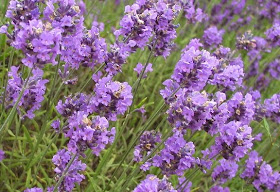Thursday, December 26, 2013
LAVENDER
Lavender-Lavandula Augustifolia, Lavandula Officinalis, Lavandula Vera, Lavandula Steochas, Lavandula Spica
Also known as: Garden lavender, Spike lavender, Common lavender
Parts used: flowers, leaves
Meridians/Organs affected: lungs, liver, skin, digestive, nervous system, circulatory
Properties: carminative, antidepressant, antispasmodic, nervine, aromatic, stimulant, tonic, diuretic, antiseptic, vulnerary, antifungal, antibiotic, antibacterial, anti-inflammatory
Lavender is a member of the Labiatae family. It is a gray-green, shrub-like plant with flowering spikes that vary from mauve to deep purple depending on the variety. The leaves will also differ in size depending on the variety. They can get between two and three feet tall and are very aromatic when touched although the aroma doesn't last for long. Lavender blooms between June and July, and if using the flowers and/or leaves for medicinal purposes, they should be gathered before they flower.
There are three main types of lavender. The are lavender vera (which includes lavender augustifolia and lavender officinalis and is better known as English lavender or True lavender), lavender spica (spike lavender), and lavender steochas (French lavender). Any other lavenders on the market are considered to be hybrids.
The English and French lavenders have the highest quality oil used mainly for commercial use (although they have many medicinal uses as well) in soaps, sachets, bathroom products, perfumes and sprays. Spike lavender produces more oil but is not as aromatic. It takes 220 pounds of lavender flowers to get 1 1/2 to 2 1/2 pounds of essential oil. It takes one acre of lavender to distill 25 pounds of oil.
Lavender is native to southern Europe but is now grown commercially in France, Bulgaria, Spain, Russia, Tasmania and England.
Lavender has been used since ancient times and was well known to the Greeks and Romans who used it as a perfume as well as a medicine. The Latin 'lavare' means 'to wash' which is how the Romans mainly used it-added to their bathwater. Many of the early physicians (Dioscorides, Pliny, Galen) spoke of using lavender and Hildegarde of Bingen dedicated a whole chapter to it in her medical writings. It was commonly found in medicinal gardens in monasteries in the 13th and 14th centuries.
Lavender didn't start to be commercially cultivated until around 1823. Matthiole, a 16th century botanist, use lavender for mental issues, fluid retention, epilepsy and apoplexy (unconsciousness or incapacity associated with stokes or cerebral hemorrhaging). The French would make an herbal tea that was said to cure jaundice using lavender, fennel and cinnamon. This same tea was also said to be a wonderful cardiac tonic. In Tuscany, lavender was said to protect children from the 'evil eye' and in Africa the Kabyle women believe it protects them from being abused by their husbands. The tea has been used over the years to prevent fainting and to dispel feelings of nausea.
This plant also has been used for drawer or linen sachets to keep moths and insects from destroying clothing. Herbalists have used lavender oil for hundreds of years to kill various strains of bacteria including strep, typhoid, diphtheria and pneumococcus. It has also traditionally been used for coughs, colds and chest infections as well as a sedative and as a relaxing or calming agent. An infusion of the dried herb or oil is good for headaches caused by nervous tension and the oil diluted with a carrier has been used for millennia for massage and to ease rheumatic and neuralgic pains. Lavender also has cytophylatic abilities which means it protects cells and has regenerative capabilities. It was not only an ingredient of smelling salts but was also part of the herbs d' Provence culinary spice blend.
In medieval Europe lavender was an herb that was looked upon as a protectant of chastity and as an herb of love. William of Yardley was granted a royal monopoly by Charles I of England to produce lavender as a commercial crop. (This is where the famous Yardley soap obtained its beginnings.)
Workers of the lavender fields were paid 'danger money' due to the risk of bee stings when harvesting the flowers for distillation. (Wonder if that is where workers compensation got its beginnings..LOL)
In both World War I and II, lavender oil was carried by medics and soldiers to disinfect wounds. Perhaps the most well known use of lavender is for burns. This happened by accident, actually. A man called Dr. Giatte Fosse' (one of the founders of lavender therapy for burns) was working in his lab and burned his hand. He immediately plunged it into the nearest bowl of fluid-which in this case was lavender oil, and the pain stopped and the burn healed quickly thereafter.
Lavender is also very useful for leucorrhea, cystitis, vaginitis, varicose veins, frostbite, acne, cellulite, bruises and swelling. It stimulates new cell growth, calms nerves, lifts moods, fights infections, reduces inflammation, relieves pain and muscle spasms, eases congestion and helps to lower blood pressure. It is one of the most gentle herbs we have and can be used on infants, children and during pregnancy.
As is customary with my posts I am including some links for your perusal. Use as you feel necessary. Live long and be happy!
http://www.amazon.com/Starwest-Botanicals-Organic-Lavender-Flowers/dp/B003AYEHIO/ref=sr_1_1?ie=UTF8&qid=1388093237&sr=8-1&keywords=lavender
http://www.amazon.com/Now-Foods-Lavender-Oil-1-Ounce/dp/B0009RSP38/ref=sr_1_2?ie=UTF8&qid=1388093333&sr=8-2&keywords=lavender
http://www.amazon.com/Lavender-Chamomile-Bubble-Bath-17-5oz/dp/B000UVOIMU/ref=sr_1_4?ie=UTF8&qid=1388093333&sr=8-4&keywords=lavender
http://www.amazon.com/Aroma-Home-Body-Wrap-Lavender/dp/B003GMFDQK/ref=sr_1_11?ie=UTF8&qid=1388093333&sr=8-11&keywords=lavender
http://www.amazon.com/Yogi-Honey-Lavender-Stress-Relief/dp/B007M8FRV0/ref=sr_1_14?ie=UTF8&qid=1388093333&sr=8-14&keywords=lavender
http://www.amazon.com/Avalon-Organics-Lavender-Lotion-Ounce/dp/B000NW9YTS/ref=sr_1_15?ie=UTF8&qid=1388093333&sr=8-15&keywords=lavender
http://www.amazon.com/ENGLISH-LAVENDER-Lavender-Augustifolia-Flower/dp/B004ZGL3QA/ref=sr_1_2?ie=UTF8&qid=1388093807&sr=8-2&keywords=lavender+seeds








No comments:
Post a Comment